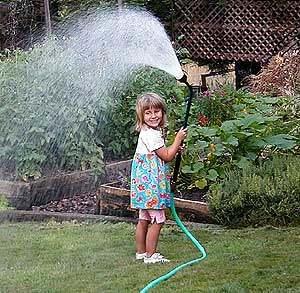Water Conservation Tips - Some Homeowner Tips
Nothing is more basic to all life than water, and this time each summer many of our conversations center around the availability of water for use in our homes. We see the flows in many streams around Trinity County drop to a trickle. We worry about our wells going dry. We know that we simply cannot live without water. But did you know that landscaping around our homes accounts for 20 to 50 percent of residential water use?
It takes about 27,000 gallons of water to irrigate one acre of lawn in California every summer. How much IS 27,000 gallons of water:
- Enough water to make 27,000 gallons of iced tea!
- A 15 gallons per minute pump would have to run for 30 hours to give you that 27,000 gallons of water.
- One person could take a 10-minute shower every day for about 3 years using any showerhead that has been on the market since 1994.
So doesn’t it make sense (actually dollars and cents) to do what we can to save water by reducing the amount that we use outside of the house every summer?
 |
Here are some simple ways that you can cut down on your outside water uses.
- Water your lawn before 8 A.M. or after 6 P.M to avoid the heat of the day when more water evaporates.
- Avoid watering on windy days. The wind increases evaporation & reduces the amount of water that actually gets to the roots of your lawn or plants.
- Water in several short sessions rather than one long one. For example, three 10-minute sessions spaced 30 minutes apart will allow your lawn to better absorb moisture than one 30-minute session.
- Only water when your lawn is thirsty. Over watering promotes shallow roots and makes your lawn less hardy. If you walk across your lawn and you leave footprints, its time to water.
- Maintain a lawn height of 2 ˝ to 3 inches to help protect roots from heat stress and reduce evaporation of moisture.
- Avoid planting turf in areas that are difficult to irrigate properly, such as very steep slopes and isolated strips next to driveways or sidewalks.
- Mulch around plants, bushes and trees to help keep the soils moist.
- Add new plants in the spring or fall when the plants will need less water to become established.
- Plan your landscaping to put plants with similar watering needs in the same planting area and match plants to the conditions of the planting area such as sunny, shady, dry or damp.
- Consider installing more efficient watering systems, like drip irrigation, that deliver the water only to the plants not the sidewalk, driveway or nearby street.
- If you have an automatic irrigation system check for leaks.
- Avoid sprinklers that spray a fine mist, which increase evaporation.
These any many other helpful hints can be found at "WaterWiser – The Water Efficiency Clearinghouse" of the American Water Works Association at www.waterwiser.org.
|


